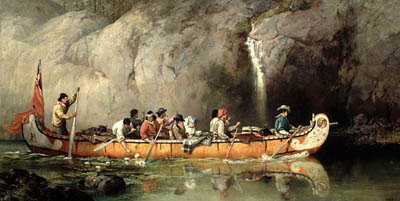Charles Oakes Ermatinger, fur trader, merchant, militia officer and Justice of the Peace (born 1 February 1776 in Montreal, Quebec; died 4 September 1833 in Montreal). Ermatinger played an important role in the economic and social life of the frontier region of Sault Ste. Marie and what was then known as the Upper Country.

Early Life
Charles Oakes Ermatinger was the youngest son of Swiss-born merchant Lawrence Ermatinger and his British-born wife Jemima. Charles received a good education in Montreal and became a clerk for the North West Company in 1795. He journeyed to the Upper Country west of Lake Superior — le pays d’en haut — in 1798 with a trader named L’Etang, who was associated with the New North West Company, also known as the XY Company.
Marriage to Mananowe
In 1799, Ermatinger married Mananowe, daughter of Katawabeda [also Katawabidai], the influential chief of the Sandy Lake band of the Ojibwa. The union was according to Ojibwa custom. Such “country marriages” (as they were called at the time) between white traders and Indigenous women were common. While some traders considered them temporary arrangements of convenience, Ermatinger and Mananowe remained together for the duration of his life. Mananowe, who adopted the name Charlotte, bore 12 children, five of whom died in childhood. In addition to English and French, Ermatinger spoke Ojibwa. In the Ermatinger family, both Indigenous and European heritage were considered important.
North West Company
At some point Ermatinger went to work for John Ogilvy of the New North West Company (NNWC). However, he joined its competitor, the North West Company (NWC), in 1800. (In 1804, the NWC absorbed the NNWC). Company minutes indicate that he was well respected at NWC.
By 1806, Ermatinger was stationed at Bas de la Rivière in the Lake Ouinipique (Winnipeg) department under William McKay. He and colleague George Nelson travelled a large circuit in the Red River area, visiting Indigenous clients. Ermatinger planted crops and founded a fishery to help offset a diminishing fur harvest in the area. Nelson later wrote in his Reminiscences that it was “a hard country indeed … [and] required the utmost prudence, foresight and economy … to procure enough for mere subsistence. He (Ermatinger) managed so well, however, that he had a tolerable good winter of it.”
Independent Trader
Ermatinger left the NWC in 1807 for unknown reasons. In his Reminiscences, George Nelson states, “Mr. Ermatinger … had also ‘gone to Montreal’, an equivalent, in our vocabulary, to disgrace, which he certainly for many reasons did not deserve.” The company may have thought Ermatinger was too generous when dealing with his wife’s family. Perhaps he was unhappy when the NWC reduced wages after it absorbed the NNWC. When he left, Ermatinger was paid £600 for his services and agreed not to engage in trade at the expense of the NWC for seven years.
Despite this agreement, Ermatinger built a trading post at Sault Ste. Marie on the north (British) side of the St. Mary’s River, about 2.5 km below the rapids where the NWC post was located. His brother Frederick William was his agent in Montreal. Ermatinger was familiar with the area, having once served in a NWC post on the American side. The business venture was immediately successful. By 1812, he employed 50 people.

Ermatinger Old Stone House at the Ermatinger-Clergue National Historic Site of Canada, Sault Ste. Marie, Ontario.
(photo by Fungus Guy/Wikimedia CC)
War of 1812
Growing friction between Great Britain and the United States led to the Non-Intercourse Act, passed by the American government in 1809. This legislation was designed to hamper the activities of British-Canadian fur traders in American territory. Ermatinger continued to operate south of the St. Mary’s River, competing with John Jacob Astor’s American Fur Company.
On 17 July 1812, Ermatinger was a militia captain in Captain Charles Roberts’ expedition against the American fort at Michilimackinac. Roberts credited Ermatinger’s local knowledge in the bloodless capture of the post. During the summer of 1814, Ermatinger was taken prisoner when American troops pillaged the British side of Sault Ste. Marie. His buildings were among the few not destroyed, and he was soon released.
Postwar Activities
Charles Ermatinger prospered in Sault Ste. Marie after the war. According to author and explorer Gabriel Franchère, who arrived there on 31 July 1814, Ermatinger had a farm, windmill and “very elegant” stone house.
By 1816, Ermatinger was a Justice of the Peace for Sault Ste. Marie and an agent for Lord Selkirk of the Hudson’s Bay Company. He established a western winter express route for the Company with Sault Ste. Marie as a relay point and provided Selkirk’s Red River settlement with supplies. Selkirk was at Ermatinger’s house when he learned of the death of Governor Robert Semple and twenty HBC men. (See Battle of Seven Oaks.)
In 1816, the American government passed the Exclusion Act to discourage foreigners from trading on American soil. Despite this, Ermatinger operated south of the border successfully for several years, befriending American officials and doing business through his Ojibwa father-in-law. However, the American government eventually revoked all of his licences. In 1822, his post on the American side of Sault Ste. Marie was appropriated for the construction of a military fort. Ermatinger continued to trade on American soil, but to a lesser degree.

Montreal and Death
In 1827, Charles Ermatinger’s brother Frederick died, leaving him a substantial property at Longue-Pointe on the Island of Montreal. Economic conditions in Sault Ste. Marie had deteriorated following the merger of the North West Company and the Hudson’s Bay Company, prompting Ermatinger to retire. He moved to Montreal with his wife and children. In 1832, Charlotte and Charles were formally married in a church ceremony. He died the following year.

 Share on Facebook
Share on Facebook Share on X
Share on X Share by Email
Share by Email Share on Google Classroom
Share on Google Classroom